
Response to a crude oil spill at the Valdez Marine Terminal continues, with an estimated 400 gallons of an oily water mix recovered, more than 23,000 feet of boom deployed and over 25 vessels responding on the water, Alyeska Pipeline Service Co. officials said Sept. 23.
The response was focused on the area to the north and northwest of the terminal, around berths 4 and 5, and there were no observed areas of concentrated oil on the water, the pipeline company said.
Crews were slated to do an assessment to determine a plan for cleaning up some shoreline inside the containment area at the terminal. Meanwhile wildlife specialists were closely monitoring the affects area and had not observed any affected wildlife, the company said.
The spill, detected on Sept. 21, was initially estimated to be just up to 100 gallons. It remains under investigation by federal and state authorities.
Alyeska was working with federal and state officials, pipeline owners, pipeline shippers and marine shippers on adjusting the terminal schedule. The next tanker was due to arrive early next week, Alyeska said.
The pipeline company said in an announcement on Sept. 22 that some 185 people were involved in the response, including more than 120 responders in the field, and activating all available resources, including pre-staged equipment around Port Valdez, to response to the incident.

Photo courtesy Alyeska Pipeline
The Solomon Gulch Hatchery and Valdez Duck Flats were boomed and the skimmer Valdez Star was skimming to the north of the Valdez Marine Terminal with five vessels pulling some 1,700 feet of absorbent boom.
Within a day, 221 gallons of emulsified oil and water was recovered, which indicated a spill larger than initially estimated,” the company said,
The U.S. Coast Guard meanwhile established a safety zone from the western edge of the Valdez Marine Terminal security zone to Anderson Bay, and all vessels not involved in the response were asked to avoid that area. Mariners were advised to avoid the booming around Solomon Gulch Hatchery and the Valdez Duck Flats.
Early indicators showed that a check valve in Alyeska’s fire water system may have failed during a pressure test, allowing contents of a berth loading arm to drain through the fire water system, DEC officials said.
While the oil slick is not yet contained, the source of the leak in berth 5 of the terminal has been secured, so it is not leaking any more, said Geoff Merrell, the agency’s environmental program manager.
Earlier estimates from Alyeska were that between 10-50 gallons of crude spilled.
The Ship Escort/Response Vessel System was responding with a variety of oil spill clean-up boats and skimmers, including the skimmer Valdez Star, DEC said. SERVS was created in the aftermath of the March 24, 1989 Exxon Valdez oil spill disaster to provide spill prevention and spill cleanup efforts.
DEC officials said that plans are to clean up the spill, protect environmental resources and investigate the cause of the incident. Meanwhile the trans-Alaska oil pipeline system remains operational and there have been no impacts to operation of the pipeline itself.














